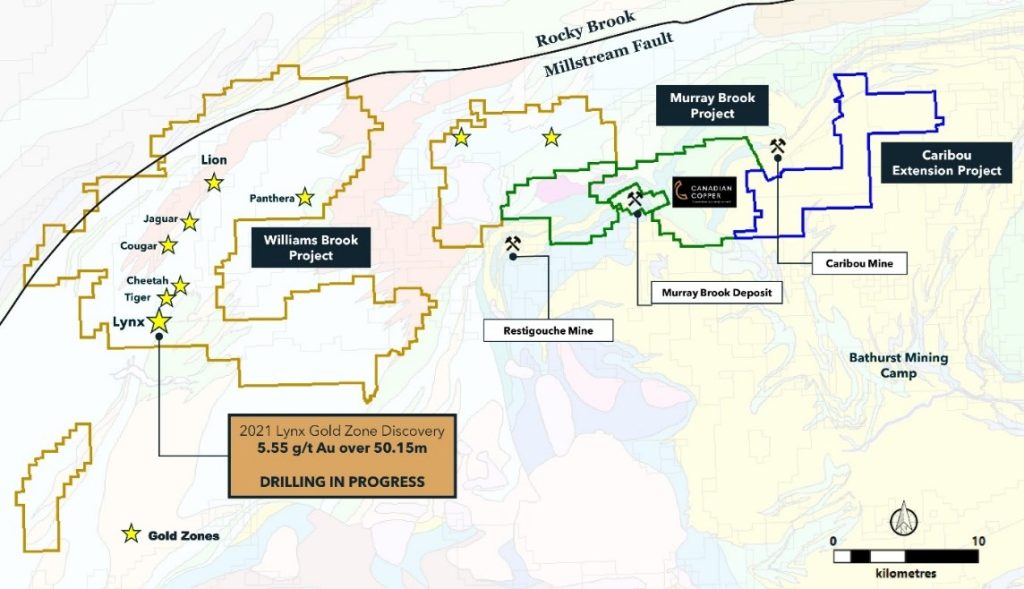Puma Exploration Hits Visible Gold at Record Depth in Williams Brook Drilling
Puma Exploration (TSXV: PUMA, OTCQB: PUMXF) has resumed drilling at its Williams Brook Project in northern New Brunswick after operations were temporarily suspended due to provincial wildfire restrictions. The company announced a significant milestone with the discovery of visible gold at 355 meters downhole in drill hole WB25-181, marking the deepest gold intersection recorded at the project to date.
The current drill
...
Puma Exploration Hits Visible Gold at Record Depth in Williams Brook Drilling
Puma Exploration (TSXV: PUMA, OTCQB: PUMXF) has resumed drilling at its Williams Brook Project in northern New Brunswick after operations were temporarily suspended due to provincial wildfire restrictions. The company announced a significant milestone with the discovery of visible gold at 355 meters downhole in drill hole WB25-181, marking the deepest gold intersection recorded at the project to date.
The current drilling program, which has completed six holes totaling 1,343 meters, was temporarily halted on August 10 when New Brunswick implemented restrictions on mineral exploration activities on Crown land due to wildfire concerns. With those restrictions now lifted, Puma has restarted its fully funded $2 million exploration program being conducted in partnership with Kinross Gold Corporation.
The visible gold discovery in hole WB25-181 occurred at a vertical depth of approximately 250 meters within a brecciated quartz-carbonate vein. This intersection potentially extends the known gold mineralization by about 100 meters along a favorable geological contact. The mineralized zone exhibited discontinuous quartz-carbonate veins with stockwork texture and contained minor sulphide mineralization including pyrite, sphalerite, chalcopyrite, and galena.
“Intersecting visible gold at this depth confirms our geological model and the potential for significant mineralization well below the oxide zone,” said Marcel Robillard, President and CEO of Puma Exploration, in a statement to investors. “This is an encouraging development as we continue to build our understanding of the Williams Brook gold system.”
The current drilling program at the Lynx Gold Zone is designed to test new target areas, define key geological contacts, and improve understanding of the structural controls on gold mineralization. The planned 3,500-meter campaign represents a systematic approach to expanding the known mineralized envelope while testing the depth potential of the system.
In parallel with drilling activities, Puma has conducted extensive channel sampling at the Lynx zone, collecting 410 samples to investigate various vein systems. Results from both the drilling and sampling programs are pending and will be released once received and interpreted.
The exploration strategy for Williams Brook extends beyond the Lynx zone. The Joint Technical Committee, established as part of the Kinross partnership, has approved a 1,500-meter drilling campaign at the Jaguar Gold Zone (JGZ), located approximately 5 kilometers northeast of Lynx. This program will follow up on encouraging historical results and recent trenching data.
Historical drilling at Jaguar from 2008 returned intervals including 0.52 g/t gold over 55 meters, 0.68 g/t gold over 42 meters, and 0.21 g/t gold over 64 meters. More recent trenching work by Puma in 2022 yielded higher grades, with grab samples returning values up to 34.70 g/t gold. From 306 samples collected during that campaign, 31% assayed above 1.00 g/t gold, with an average grade of 1.72 g/t gold across all samples.
The mineralized footprint at Jaguar currently spans 80 by 50 meters and remains open in all directions, suggesting significant expansion potential.
Across the broader Williams Brook Project, Puma has collected 570 samples from prospecting, trenching, and excavating operations targeting high-priority areas identified by the technical committee. Approximately 2,265 meters of trenching has been completed to date, with exploration work also commencing at the Jonpol and Portage properties within the project area.
The Williams Brook Project represents a substantial land package covering 40,225 hectares in northern New Brunswick. Under an option agreement signed earlier this year, Kinross Gold can earn a 65% interest in the project by funding a minimum of $16.75 million in exploration expenditures over five years, including a firm commitment of $2 million and at least 5,000 meters of drilling within the first 18 months.
The project’s strategic location near the Rocky Brook Millstream Fault – a significant structural feature formed during the Appalachian Orogeny – is considered a key advantage. Regional geologists believe this structural corridor controls gold deposition throughout the area, similar to other major gold systems in the Appalachian Belt.
While Williams Brook remains Puma’s flagship asset, the company’s portfolio includes several other gold-focused properties in northern New Brunswick, including the McKenzie Gold Project. All properties benefit from proximity to infrastructure and road access, facilitating year-round exploration activities when weather and regulatory conditions permit.
The resumption of drilling at Williams Brook comes during a period of increased interest in Atlantic Canada’s gold potential, with several companies advancing projects across New Brunswick and neighboring provinces.


